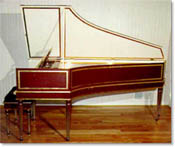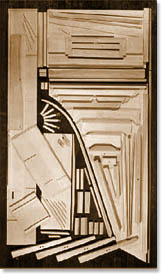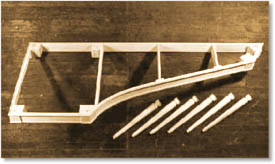We offer three harpsichord
and virginal kits:
French
Double-manual Kit
 We
have chosen as the prototype for our French harpsichord kit an instrument
made in Paris in 1769 by Pascal Taskin, possibly the most famous of
all 18th century French makers. We made this choice because the mid-18th
century French style harpsichord represents the most successful "general"
purpose instrument. The instrument is suitable to all of the harpsichord
literature of the baroque. We
have chosen as the prototype for our French harpsichord kit an instrument
made in Paris in 1769 by Pascal Taskin, possibly the most famous of
all 18th century French makers. We made this choice because the mid-18th
century French style harpsichord represents the most successful "general"
purpose instrument. The instrument is suitable to all of the harpsichord
literature of the baroque.
 The
completed kit rewards the builder with a double-manual instrument of
elegant proportion and detail having a range of five octaves, FF-f'''
(61 notes). There are three ranks of jacks and three choirs of strings,
2 x 8', 1 x 4', with a buff stop which can be installed on either the
back 8' choir or the upper-manual 8'. An additional peau de buffle
register with leather plectra can be added to the lower-manual 8' if
the builder chooses. The transposing keyboards are replicas of Taskin's
keyboards. The
completed kit rewards the builder with a double-manual instrument of
elegant proportion and detail having a range of five octaves, FF-f'''
(61 notes). There are three ranks of jacks and three choirs of strings,
2 x 8', 1 x 4', with a buff stop which can be installed on either the
back 8' choir or the upper-manual 8'. An additional peau de buffle
register with leather plectra can be added to the lower-manual 8' if
the builder chooses. The transposing keyboards are replicas of Taskin's
keyboards.
The
steel wire normally supplied with our kits is of a lower tensile strength
than modern music wire. Its tensile strength reproduces that of the
wire used in the 18th century and its high flexibility produces a tone
somewhat richer in the lower harmonics and clearer in overall impression
than harder wire.

French
kits include a trestle stand. However, continental harpsichords in the
mid 18th century were often supported by a set of turned and fluted
legs attached to a low rim or apron. Later the legs were often attached
directly to the bottom of the instrument. We offer the builder the option
of purchasing in place of the trestle stand either a set of Louis XVI
style legs, which can be screwed to the bottom of the harpsichord, or
a Louis XVI apron, fully assembled with decorative moldings and screw-on
legs. Other options are listed in our catalogue and price list.
Listen
to the French double kit...
We now have
a demonstration CD of this instrument
available ($10.00 ppd. in U.S.). Please - inquire via our
contact form.
Send
for a Kit Catalog and Price Guide

Flemish
Single-manual Kit
 For
those builders whose musical requirements are considerable but whose
resources are limited, our Flemish single-manual kit with its bold sound
and unusually large range is ideal. Designed as a small concert harpsichord
with transposing keyboard and a compass capable of performing virtually
the entire baroque literature, the resulting instrument amply rewards
the player with substantial artistic demands. Compact and light, this
harpsichord is practical for the professional on tour and for amateur
ensembles that require frequent moves. For home or institution, professional
or student, we offer no better value. For
those builders whose musical requirements are considerable but whose
resources are limited, our Flemish single-manual kit with its bold sound
and unusually large range is ideal. Designed as a small concert harpsichord
with transposing keyboard and a compass capable of performing virtually
the entire baroque literature, the resulting instrument amply rewards
the player with substantial artistic demands. Compact and light, this
harpsichord is practical for the professional on tour and for amateur
ensembles that require frequent moves. For home or institution, professional
or student, we offer no better value.
The
kit is patterned on an instrument built in Antwerp in 1584 by Hans Moermans.
We have followed the 18th century practice of ravalement and
extended the range of the original from 55 to 58 notes (GG-e''' chromatic).
We have also added a French 18th century scaling. It is disposed with
two eight foot (8') stops and a buff stop.
Like
the French harpsichord kit, the Flemish Single-Manual Kit is available
with a number of options, among them block printed papers (replicas
of traditional Flemish designs) to decorate the interior of the instrument.
Listen
to the Flemish single kit...
We now have
a demonstration CD of this instrument
available ($10.00 ppd. in U.S.). Please - inquire via our
contact form.
Send
for a Kit Catalog and Price Guide

Flemish
Single- & Double-Manual Virginal Kits:
"Mother & Child"
 Flemish
virginals emerged in the 17th century as two distinct instruments depending
on which side of the front of the instrument the keyboard was located.
Those with the keyboard positioned to the right were known as muselars
and produced a round, fluty sound of unusual power. The spinet
whose keyboard lies to the left of the center produces a sound approaching
that of the wing-shaped harpsichord of the period. The ottavino
or "Child" virginal lives in the body of the "Mother"
and is pitched one octave higher than either the spinet or the
muselar virginals. When played, it is pulled forward like a drawer
in a bureau, or removed completely and placed on top of the eight-foot
virginal cleverly forming a second keyboard at four-foot pitch. Flemish
virginals emerged in the 17th century as two distinct instruments depending
on which side of the front of the instrument the keyboard was located.
Those with the keyboard positioned to the right were known as muselars
and produced a round, fluty sound of unusual power. The spinet
whose keyboard lies to the left of the center produces a sound approaching
that of the wing-shaped harpsichord of the period. The ottavino
or "Child" virginal lives in the body of the "Mother"
and is pitched one octave higher than either the spinet or the
muselar virginals. When played, it is pulled forward like a drawer
in a bureau, or removed completely and placed on top of the eight-foot
virginal cleverly forming a second keyboard at four-foot pitch.
How
the "Mother & Child" work: In the large virginal a
single set of strings runs the length of the virginal which is normally
positioned in the room against a wall. The key levers run underneath
the soundboard from front to back increasing in length as they progress
from bass to treble. This allows them to have about the same mechanical
advantage in lifting the jacks throughout the compass of the instrument.
The key levers are guided vertically at the back with a rack and overrail
to limit the amount of key dip. The balance mortises are also made in
the manner of the old makers by punching directly into the key lever.
The keys lift the jacks which rise through a leather covered register
set into the soundboard. The jacks face alternately toward and away
from the player making it possible for the strings to fit into half
the space they would normally occupy in a harpsichord.
The
action and lay-out of the diminutive ottavino are similar to
the large instrument. The salient feature of the ottavino is
its extreme compactness. In order to couple the ottavino to the
large virginal the jackrail of the large virginal is removed and the
ottavino set in its place. When played from the lower keyboard,
the jacks of the large virginal then perform double duty by both plucking
the eight-foot strings and raising the ottavino keys through
a slot cut in the bottom of the smaller instrument. This provides the
player with a 1 x 8', 1 x 4' disposition. One would be hard put to use
a half-pint of paint on the ottavino. Its construction is as
straightforward and simple as is possible for a harpsichord to be. We
rank this as our easiest kit.
Both spinet
and muselar kits are designed with the ottavino in mind.
Any Hubbard ottavino will fit any Hubbard muselar or spinet
virginal. It is, of course, possible to build the large virginal
first and add the ottavino later, or vice-versa. The range is C-c''',
49 notes. Both spinet and muselar are disposed 1 x 8', the ottavino
is disposed 1 x 4'.
With our large virginal kits we include a trestle stand in oak with
four turned legs. A 17th century oak joint stool kit is available
that nicely complements the stand.
Listen
to the Flemish virginals kits...
We
now have a demonstration CD of this instrument
available ($10.00 ppd. in U.S.). Please - inquire via our
contact form.
Send for a Kit Catalog and Price
Guide

|